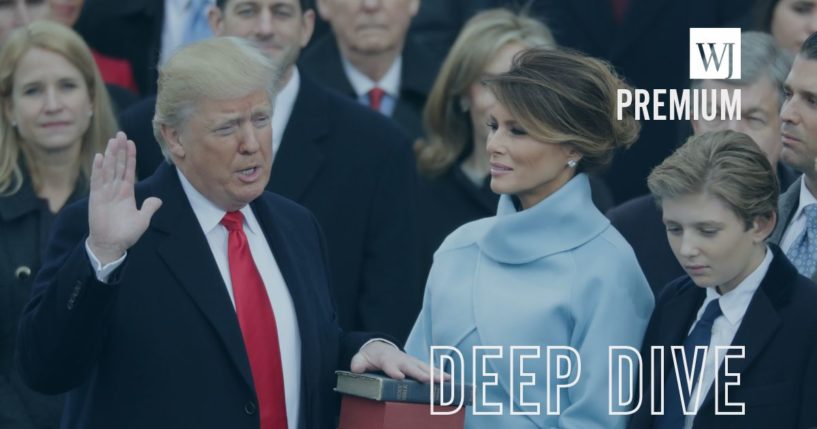
Five Reasons 2024 Is Shaping Up Like 2016 for Trump
If you’re feeling like it’s 2016 all over again regarding Donald Trump’s prospects of becoming president, you have good reason.
There are at least five interesting parallels to that campaign and how the 2024 presidential race is shaping up.
As a side note, if Trump is successful in winning the Republican nomination and then the general election, he will be only the second person in history to serve non-successive terms: The first was Grover Cleveland, the Democrat who was the 22nd and 24th president in the late 1800s. Trump would be the 45th and 47th president.
Before getting into the parallels between 2016 and now, it’s worth noting that establishment media outlets certainly see a Trump victory as a real possibility, given he has polled ahead of President Joe Biden in key swing states.
Here are some recent headlines: The New York Times, “Why a Second Trump Presidency May Be More Radical Than His First”; The Atlantic, “If Trump Wins”; The Washington Post, “A Trump dictatorship is increasingly inevitable. We should stop pretending.”
Then there’s former Wyoming Rep. Liz Cheney, the favorite Republican of former House Speaker Nancy Pelosi, engaging in the most ridiculous Chicken Little hyperbole about Trump.
She warned on CBS over the weekend that a second Trump term would be the “end of the republic” and on NBC’s “Today” this week that Trump would try to stay on as president “forever.”
“He’s already done it once,” Cheney said.
Please. Did Trump leave the White House on Jan. 20, 2021, as Joe Biden became president? Yes, he left of his own accord, even as he questioned the integrity of election results and challenged them in court.
That’s happened many times in U.S. history. Former Democratic nominee Hillary Clinton still says the 2016 election was “stolen” from her. She took court action in Wisconsin following Trump’s victory, and her attorney, Marc Erik Elias, called for audits in Michigan and other states.
What would it even look like if Trump wanted to stay in the White House past Jan. 20, 2029? He wouldn’t be eligible to run in 2028 without a constitutional amendment. He doesn’t have the power to call off elections. Who would even enforce such a decree if he made it? The Department of Justice? The courts? The military? Come on, man!
Tonight, Joe Biden said, “This is a nation that respects free and fair elections. We honor the will of the people. We do not deny it.”
Here’s 10 minutes of Democrats denying election results:pic.twitter.com/I0oUumk68d
— Steve Guest (@SteveGuest) September 2, 2022
So enough of the silly talk. Cheney is just trying to sell books and gain a higher profile for a possible independent presidential bid.
All of the over-the-top headlines about Trump prompted Washington Examiner chief political correspondent Byron York to post on X.
“The alarm has gone off,” he wrote. “Around this time in 2015, some in political/commentary class realized Trump could win GOP nomination. Freakout ensued, although many remained confident Trump could not win general. Now, warning machine has kicked into higher gear.”
The alarm has gone off. Around this time in 2015, some in political/commentary class realized Trump could win GOP nomination. Freakout ensued, although many remained confident Trump could not win general. Now, warning machine has kicked into higher gear. pic.twitter.com/ZRtnloWAw2
— Byron York (@ByronYork) December 4, 2023
The media mobilizing to try to thwart a Trump presidency is one parallel to 2016, but here are five more:
Democratic Candidate Unpopular, Scandal-Plagued
One of the things Trump had going for him in 2016 was that Democratic nominee Hillary Clinton was very unpopular — as Biden is now.
Trump and Republicans called her integrity into question given the seeming pay-for-play regarding the Clinton Foundation and her erasure of more than 30,000 emails that were the subject of a congressional subpoena.
Recall how Clinton first said the deleted emails on her unsecured home server were only personal in nature (yoga routines, etc), then changed her story to say there were no classified materials in the emails, and finally claimed none was marked classified. All those statements proved false.
The Democratic nominee also had been secretary of state when militants overran the U.S. consulate in Benghazi, Libya, in 2012, resulting in the deaths of four Americans, including Ambassador Chris Stevens.
Clinton’s favorability rating in late August/early September 2016, just months before the election, was 38 percent, according to Gallup.
Biden, the incumbent in 2024, is also very unpopular, with a current Gallup job approval rating of 37 percent.
The president’s integrity also is in doubt given his false claims of having had no knowledge of or involvement in his son Hunter Biden’s shady business dealings.
As Clinton did with Benghazi, Biden presided over the disastrous withdrawal from Afghanistan in 2021 when 13 Americans and 170 Afghans were killed outside the airport in Kabul.
Swing States Are Trending Toward Trump
The next parallel to the 2016 election is the key swing states Trump needs to win the election are trending his way.
In 2016, he carried the Democrats’ “blue wall” states of Pennsylvania, Michigan and Wisconsin, marking the first time a Republican presidential candidate had taken them since the 1980s.
A New York Times/Sienna poll published last month showed Trump with significant leads in two of the three in a hypothetical rematch against Biden. In Pennsylvania, he was up by 4 percentage points, and in Michigan, he had a 5-point lead.
The poll showed him behind Biden by 2 percentage points in Wisconsin. However, Trump was up in other swing states Biden carried in 2020, including Nevada (10 points), Georgia (6 points) and Arizona (5 points).
Other polls have had similar findings.
If everything were to play out as it did in 2020 but with Trump carrying just Arizona, Georgia and Michigan, for example, he would be elected president on a 277-261 Electoral College vote.
Liberal Independent and Third-Party Candidates
In 2016, liberal Green Party candidate Jill Stein garnered more votes than Trump’s margin of victory over Clinton in Michigan, Wisconsin and Pennsylvania.
Stein did not run in 2020, but she announced last month she will be a candidate again in 2024.
Additionally, environmental attorney Robert F. Kennedy Jr. is an independent candidate who is likely to pull more votes from Biden than Trump, assuming they are their parties’ nominees.
Finally, former Harvard professor Cornel West, who is also running as an independent, also will pull votes from Biden, assuming he gets on the ballot.
Cheney might get into the contest as a NeverTrump alternative and take a few percentage points of the vote, but, on the whole, the third-party and independent candidate mix appears to be shaping up in Trump’s favor.
The Obama/Biden Agenda
Trump has argued that but for his White House predecessor, President Barack Obama, and that administration’s leftist agenda, he never would have been elected president.
“The reason I’m here is because of President Obama and Joe Biden, because if they did a good job, I wouldn’t be here,” Trump told reporters in the summer of 2020.
“And probably if they did a good job, I wouldn’t have even run,” he added.
Obama oversaw the slowest economic recovery since World War II and the first $1 trillion-plus deficits.
Federal spending rose under Obama from $2.98 trillion in fiscal 2008 before he took office to $3.9 trillion in fiscal 2016, his last full year as president.
Obama set a record for the number of pages of regulations contained in the Federal Register, taking it from 81,405 pages in 2010 to 97,110 pages during the last year of his presidency.
Politico reported in January 2016 that the Obama administration was seeking to push through nearly 4,000 new regulations, many of which individually were costing industries over $100 million.
By contrast, Trump focused on cutting regulations.
The CATO Institute reported in 2020 that the 45th president took 243 deregulatory actions in his first 24 months and offered just 90 major regulations (those having significant economic impact) versus 176 under Obama during the same period.
Trump zeroed in on growing the economy, while Obama pushed for equity, trying to “spread the wealth around” through higher taxes on the wealthy and new government programs.
When asked during a presidential debate in 2008 what government programs he would cut, the Democrat could not name a single one.
Obama constantly engaged in class warfare, charging that the wealthy were not paying their “fair share” of taxes, though even following the Trump tax cuts that Democrats hated, the top 50 percent of wage earners pay nearly 90 percent of all federal income taxes and the bottom 50 percent pay just 10 percent.
The top 10 percent pays nearly 50 percent of all federal income tax revenue.
Biden, like Obama, has continually harped on equity and “fair share” while increasing government spending to record levels and igniting the highest inflation rate in 50 years.
In fiscal 2019, prior to the COVID pandemic-related outlays, the federal government spent $4.4 trillion under Trump. By comparison, federal spending in fiscal 2023 under Biden was $6.13 trillion.
Trump Against the Establishment
A final parallel to Trump’s 2016 race is he’s once again running as an outsider against the D.C. establishment.
By contrast, in 2020, he was an incumbent having to defend the government’s actions amid a once-in-a-century pandemic.
In the meantime, candidate Biden could argue he would handle it all better, in other words, the sirens’ song: “The grass will be greener if you put me in charge.”
When he took office, Biden proceeded to implement more draconian policies at the federal level as the pandemic continued for the next year-plus.
In 2024, Trump enjoys the best of both worlds.
He has a record to run on: low unemployment, low inflation, relative peace around the world and border security.
Meanwhile, he’s also an outsider who can promise to bring change to the nation’s capital.
At this point, 2024 is shaping up to be 2016 all over again.
Truth and Accuracy
We are committed to truth and accuracy in all of our journalism. Read our editorial standards.
Advertise with The Western Journal and reach millions of highly engaged readers, while supporting our work. Advertise Today.












